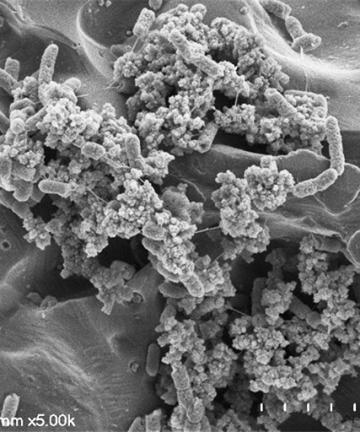Study sheds light on Salmonella survival in food processing
Ongoing research will explore microbial ecology within meat processing environments, interactions within pathogen-environmental biofilms.
January 10, 2024

In an ongoing battle against foodborne pathogens, researchers have uncovered a promising avenue for enhancing food safety through the exploration of bacterial interactions within the food processing environment. This pivotal research centers on the interplay between Salmonella and environmental biofilms, and has significant implications for the broader field.
A groundbreaking study by USDA Agricultural Research Service research microbiologist Rong Wang shed light on the abilities of Salmonella to survive and adapt within food processing environments. Wang works at the ARS Meat Safety and Quality Research Unit of the U.S. Meat Animal Research Center in Clay Center, Nebraska. His study reveals several key factors contributing to Salmonella's resilience, including its remarkable ability to colonize contact surfaces, outcompete resident microorganisms and withstand sanitizers. This is largely due to its ability to engage in intricate and diverse biofilm interactions that enhance its stress tolerance. The term biofilm refers to the structured community of microorganisms that can cling to varying surfaces.
This research is a direct response to the pressing concern of pathogen contamination in food processing settings. Pathogens like Salmonella not only endanger food quality but also pose a significant risk to public health. Unlike previous studies that mainly focused on single-species biofilms, this research tackles the more complex and realistic scenario where pathogens coexist with a multitude of environmental microorganisms in intricate mixed biofilms.
Biofilms in food processing environments represent a substantial food safety risk. They have the potential to harbor pathogens, contribute to contamination and degrade product quality. This research is the first step in unraveling the intricate science underlying these real-world interactions, and providing insights that can reshape food safety practices across the industry.
The diverse nature of Salmonella, with its extensive range of strains (serovars), raises the question of whether the survival and adaptation strategies identified in this study apply to other bacterial pathogens with similar diversity. Preliminary findings suggest that different bacterial pathogens may employ similar strategies to navigate their environment and interact with other species for survival. Ongoing research efforts aim to explore how environmental microbiomes influence the tolerance and survival of various foodborne pathogens.
By unraveling the intricacies of Salmonella's survival and prevalence in processing plants, researchers gain invaluable insights into the role of environmental factors in shaping pathogen behavior. This understanding opens avenues for targeting unique environmental species that can either protect or inhibit Salmonella, offering precise monitoring and intervention points. Implementing these findings could result in more effective environmental control measures, ultimately reducing Salmonella prevalence and its potential transmission within processing facilities.
While the possibilities are promising, applying these insights to food safety practices poses several challenges.
“It is relatively easy to test the function of environmental bacteria against pathogens in the lab,” says Wang. “However, it is hard to predict the exact interactions and overall consequences when these bacteria coexist with the pathogens in different food processing plants—where the subsequent interactions can vary significantly depending on location, season, temperature, processing activities, and the new bacterial species introduced by incoming animals on a daily basis. Therefore, even though it does have potential, many follow-up studies and monitoring are required to optimize an exact approach.”
Ongoing research initiatives will explore the association between environmental microbial communities and pathogen prevalence, the microbial ecology within meat processing environments, and the complex interactions within pathogen-environmental biofilms.
“To understand the science going on behind the scenes in the real world is very fascinating to me,” says Wang. “That’s why I chose environmental biofilms in meat plants and their influence on pathogen survival as my research focus since it is very relevant to the industry and to public health.”
This groundbreaking research sheds light on the pivotal role of beneficial bacteria in the fight against foodborne pathogens. By uncovering the secrets of bacterial interactions and their impact on pathogen control, transformative advances will ensure safer and more secure food production for the future.
This project was worked in collaboration with researchers at Texas A&M University.
You May Also Like


.png?width=300&auto=webp&quality=80&disable=upscale)
